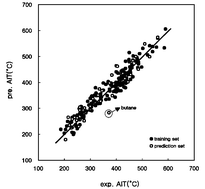Prediction of autoignition temperatures (AITs) for hydrocarbons and compounds containing heteroatoms by the quantitative structure–property relationship†
Abstract
Regression models that are useful for the explanation and prediction of autoignition temperatures of diverse compounds were provided by a quantitative structure–property relationships study (QSPR).
Genetic functional approximation was used to find the best multiple linear regression within 72 molecular descriptors. After validation by correlation of the prediction set, nine descriptor models were evaluated in the best model. The nine descriptors were Ial, Ike, radius of gyration, 1χv, SC-2, the Balaban index JX, density, Kappa-3-AM and Jurs-FNSA-2, and information of structure features and their interactions was provide.
The result of the best regression model showed that the square of the correlation coefficient (R2) for the autoignition temperature of the 157-member training set was 0.920, and the root mean square error (RMSE) was 25.876. The R2 of AIT for a 43-member prediction set was 0.910, and the RMSE was 28.968.


 Please wait while we load your content...
Please wait while we load your content...